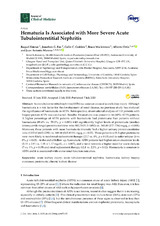Hematuria Is Associated with More Severe Acute Tubulointerstitial Nephritis
Autor
Esteras, Raquel
Fox, Jonathan G.
Geddes, Colin C.
Mackinnon, Bruce
Ortiz, Alberto
Moreno, Juan Antonio
Editor
MDPIFecha
2020Materia
Acute kidney injuryAcute tubulointerstitial nephritis
Haematuria
Kidney biopsy
Outcomes
Proteinuria
Chronic kidney disease
METS:
Mostrar el registro METSPREMIS:
Mostrar el registro PREMISMetadatos
Mostrar el registro completo del ítemResumen
Acute tubulointerstitial nephritis (ATIN) is a common cause of acute kidney injury. Although haematuria is a risk factor for the development of renal disease, no previous study has analyzed the significance of haematuria in ATIN. Retrospective, observational analysis of 110 patients with biopsy-proven ATIN was conducted. Results: Haematuria was present in 66 (60%) ATIN patients. A higher percentage of ATIN patients with haematuria had proteinuria than patients without haematuria (89.4% vs. 59.1%, p = 0.001) with significantly higher levels of proteinuria (median (interquartile range) protein:creatinine ratio 902.70 (513–1492) vs. 341.00 (177–734) mg/g, p <0.001). Moreover, those patients with more haematuria intensity had a higher urinary protein:creatinine ratio (1352.65 (665–2292) vs. 849.60 (562–1155) mg/g, p = 0.02). Those patients with higher proteinuria were more likely to need renal replacement therapy (22.7 vs. 0%, p = 0.03) and to suffer relapse (4 vs. 0%, p = 0.03). At the end of follow up, haematuric ATIN patients had higher serum creatinine levels (3.19 ± 2.91 vs. 1.91 ± 1.17 mg/dL, p = 0.007), and a trend towards a higher need for acute dialysis (7 vs. 1%, p = 0.09) and renal replacement therapy (12.1 vs. 2.3%, p = 0.12). Haematuria is common in ATIN and it is associated with worse renal function outcomes.

